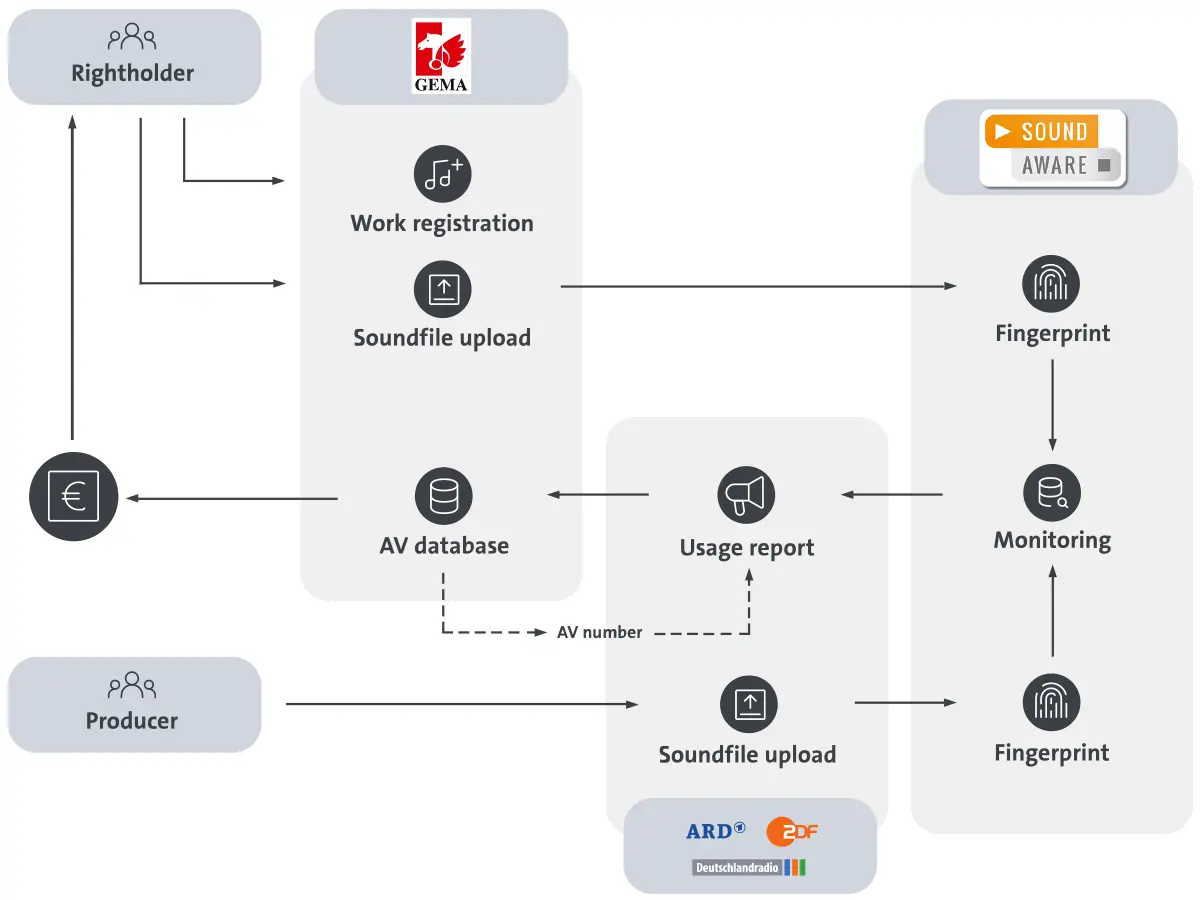
Monitoring of the public broadcasters
ARD, ZDF and Deutschlandradio have commissioned the Dutch company SoundAware to provide and operate the reporting system. The so-called "audio fingerprint technology" is being used.
How does the monitoring reporting procedure work?
The broadcast signal is analysed using audio monitoring technology. Audio fingerprinting files are created for the music used in the programmes. All audio fingerprinting files are then compared with the audio fingerprints stored in the reference database. If these match, the metadata of the audio fingerprint from the reference database, together with the programme data of the broadcast, is automatically transferred to a usage report and forwarded to GEMA and GVL.


Why is it important for authors to upload recordings of their works?
Uploading recordings of your works ensures that these works are recognised in the monitoring process and included in the broadcasters' usage reports, especially in the case of non-commercially published music (commissioned compositions, production music, etc.). The upload is therefore an important basis for you to receive distributions. If you do not have a sound file, the broadcaster is still responsible for reporting the use of the music.
It is not absolutely necessary to upload commercial music (e.g. music published on sound carriers), as this is usually already available to the monitoring service provider.
Where can I upload the recordings?
GEMA members (authors and publishers) and GEMA music users can use GEMA's sound file upload service in the online portal.
After uploading and approval for the "Monitoring of Music Usage in Television and Radio Programmes", the sound files are immediately transferred to the new reporting system of ARD, ZDF, DLR and DW or to the monitoring service provider.
Go to GEMA Soundfile Upload
FAQ - Frequently asked questions about TV monitoring
The upload should be in the file format WAV (PCM, 16Bit/48 or 44.1 kHz) or mp3 (320 kbps).
Soundfiles for commissioned compositions should be uploaded no later than 14 days before broadcast. Before that, the musical work should be registered with GEMA as soon as possible. This ensures that your music can be recognised in the regular monitoring process for the reporting procedure and that the use can be reported promptly. This is the only way GEMA can process the data in time for the distribution date. If the work registration and soundfile upload are submitted too late, the data may only be included in a later distribution.
Yes, all soundfiles uploaded in the GEMA Soundfile Upload are available to SoundAware and are used for the monitoring of ARD, ZDF and Deutschlandradio. SoundAware has been connected to the GEMA Soundfile Upload since mid-2023 and thus has access to all soundfiles uploaded to GEMA and their metadata.
No. Soundfiles that have only been uploaded to the monitoring service provider BMAT are not transmitted and are not available to SoundAware. Please upload the relevant soundfiles as soon as possible to the GEMA Soundfile Upload.
In addition to direct upload via the user interface, there are the following options:
- Upload via the Soundfile API connection
- Use of the CSV upload
- Upload via external service providers such as ALV or Harvest Media
No, a direct upload to SoundAware is not provided for GEMA members. The GEMA Soundfile Upload is available for this purpose.
We recommend that you also upload the recordings to the GEMA Soundfile Upload so that the current metadata of the corresponding work registration is available to the monitoring service provider.
In order to be able to pay out royalties, we need to know who is involved in a work and with what shares. We receive this information via the work registration, which also assigns a work number to the registered works. This enables us to provide the monitoring service providers not only with soundfiles but also with the corresponding metadata from the GEMA works database. This increases the automatic processing of incoming usage reports to GEMA.
The broadcaster or the producer is obliged to upload modified soundfiles.
The reporting system is based on the support of monitoring technology. The public broadcasters generate the notifications for GEMA in different ways:
For the use of commercial music as well as production and commissioned music, the reports are regularly generated using audio fingerprint technology. If the monitoring service provider has the respective soundfile, it can be recognised automatically. The prerequisite for this is that the soundfile has been uploaded to one of the sound file upload portals (GEMA, ARD or ZDF) and that it fulfils the applicable quality requirements.
For film productions that have already been the subject of previous GEMA distributions, broadcasters can dispense with recognition by the monitoring procedure if they can already generate notifications on the basis of GEMA's identifier (so-called AVW number). GEMA supplies AVW numbers (GEMA identifier) to ARD and ZDF for film productions with a high potential for repetition or takeover by other broadcasters, on the basis of which the usage reports are generated by the broadcasters.
The broadcasters ensure the provision of data for live and live-edited recordings of all genres on radio and television.
Manual reworking by the broadcasters of unrecognised music usage in the joint music reporting system of the public broadcasters supports the reports.
The monitoring procedure determines the actual length of works used. This is displayed to GEMA in the broadcast report and used as the basis for determining the distribution amount.
The claims rules of the GEMA distribution plan remain unaffected.
However, it is essential that GEMA members upload the soundfile with the claim at the latest in order to successfully process the claim and, in particular, to participate in subsequent distributions. This does not only apply to claimed usage issues that were already the subject of the monitoring procedure in the current distribution (in particular commercial music, production and commissioned music for television and radio), but will also become relevant for other music uses by public broadcasters in the future.
Therefore, if you have not already done so, please upload the soundfile for each work that is the subject of a complaint. The quickest way to do this is via the soundfile upload in our Online Portal.
If you do not have access to the soundfile for the use of your work, you can also claim your distribution without uploading a soundfile.
GEMA will forward your details, including the uploaded sound files, to the broadcasters for processing.
Do you have any further questions?
- Phone: +49 (0) 30 58 9999 58 (Mo - Fr: 7am - 6pm)
- E-mail: fingerprint@gema.de